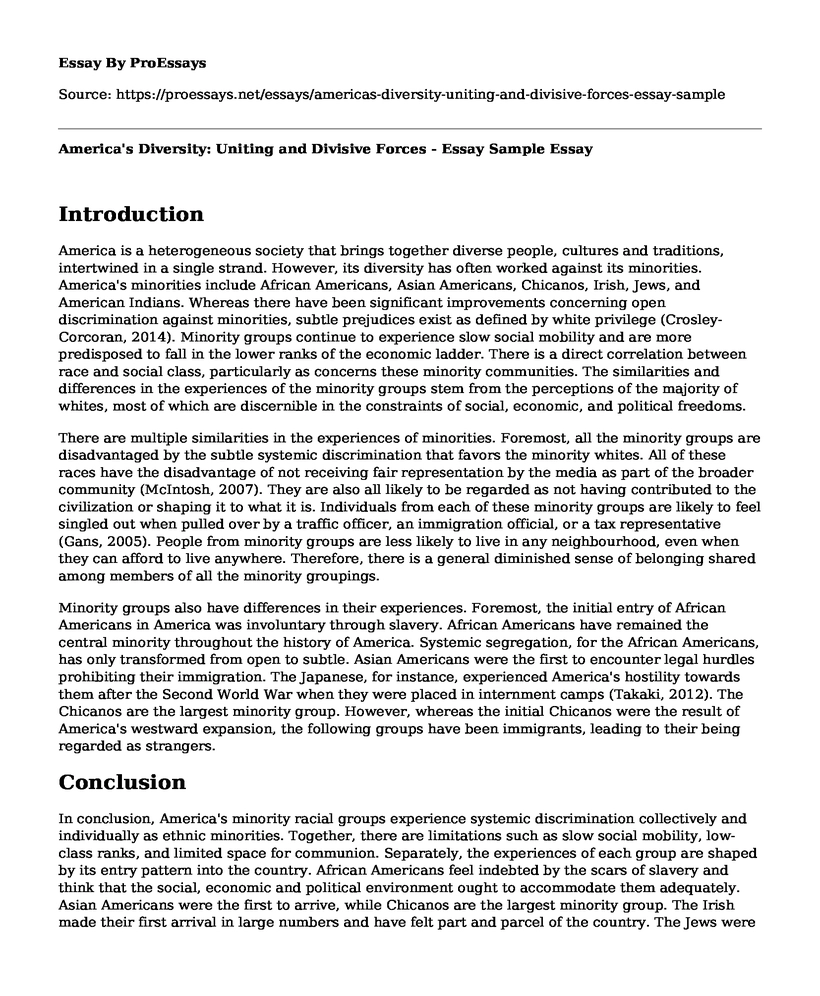Introduction
America is a heterogeneous society that brings together diverse people, cultures and traditions, intertwined in a single strand. However, its diversity has often worked against its minorities. America's minorities include African Americans, Asian Americans, Chicanos, Irish, Jews, and American Indians. Whereas there have been significant improvements concerning open discrimination against minorities, subtle prejudices exist as defined by white privilege (Crosley-Corcoran, 2014). Minority groups continue to experience slow social mobility and are more predisposed to fall in the lower ranks of the economic ladder. There is a direct correlation between race and social class, particularly as concerns these minority communities. The similarities and differences in the experiences of the minority groups stem from the perceptions of the majority of whites, most of which are discernible in the constraints of social, economic, and political freedoms.
There are multiple similarities in the experiences of minorities. Foremost, all the minority groups are disadvantaged by the subtle systemic discrimination that favors the minority whites. All of these races have the disadvantage of not receiving fair representation by the media as part of the broader community (McIntosh, 2007). They are also all likely to be regarded as not having contributed to the civilization or shaping it to what it is. Individuals from each of these minority groups are likely to feel singled out when pulled over by a traffic officer, an immigration official, or a tax representative (Gans, 2005). People from minority groups are less likely to live in any neighbourhood, even when they can afford to live anywhere. Therefore, there is a general diminished sense of belonging shared among members of all the minority groupings.
Minority groups also have differences in their experiences. Foremost, the initial entry of African Americans in America was involuntary through slavery. African Americans have remained the central minority throughout the history of America. Systemic segregation, for the African Americans, has only transformed from open to subtle. Asian Americans were the first to encounter legal hurdles prohibiting their immigration. The Japanese, for instance, experienced America's hostility towards them after the Second World War when they were placed in internment camps (Takaki, 2012). The Chicanos are the largest minority group. However, whereas the initial Chicanos were the result of America's westward expansion, the following groups have been immigrants, leading to their being regarded as strangers.
Conclusion
In conclusion, America's minority racial groups experience systemic discrimination collectively and individually as ethnic minorities. Together, there are limitations such as slow social mobility, low-class ranks, and limited space for communion. Separately, the experiences of each group are shaped by its entry pattern into the country. African Americans feel indebted by the scars of slavery and think that the social, economic and political environment ought to accommodate them adequately. Asian Americans were the first to arrive, while Chicanos are the largest minority group. The Irish made their first arrival in large numbers and have felt part and parcel of the country. The Jews were drawn by the allure of the promised land and have felt that their destiny is connected with that of other minorities. American Indians existed in America long before Columbus set foot there. The experiences of each group are thus influenced by how much attachment they feel with the country.
References
Crosley-Corcoran, G. (2014). Explaining White Privilege To A Broke White Person. Retrieved 14 February 2020, from https://www.huffpost.com/entry/explaining-white-privilege-to-a-broke-white-person_b_5269255
Gans, H. J. (2005). Race as a class. Contexts, 4(4), 17-21. Retrieved from https://journals.sagepub.com/doi/pdf/10.1525/ctx.2005.4.4.17
McIntosh, P. (2007). White privilege: Unpacking the invisible knapsack. Race, class, and gender in the United States: An integrated study, 177-82. Retrieved from https://www.racialequitytools.org/resourcefiles/mcintosh.pdf
Takaki, R. (2012). A different mirror: A history of multicultural America (Revised edition). eBookIt. com.
Cite this page
America's Diversity: Uniting and Divisive Forces - Essay Sample. (2023, Mar 30). Retrieved from https://proessays.net/essays/americas-diversity-uniting-and-divisive-forces-essay-sample
If you are the original author of this essay and no longer wish to have it published on the ProEssays website, please click below to request its removal:
- Popular Culture Annotated Bibliography
- The Impact of Ethnic Conflict on Myanmar Paper Example
- Factors That Shaped the European Attitudes Towards the Locals Essay
- Unequal Childhoods Interview Paper Example
- Essay on Michelle's Journey: From Missouri to Minnesota and Beyond
- Case Study Sample on English Tort Law: Compensating for Civil Wrong Doing
- Survival on Sea Disaster - Paper Sample







